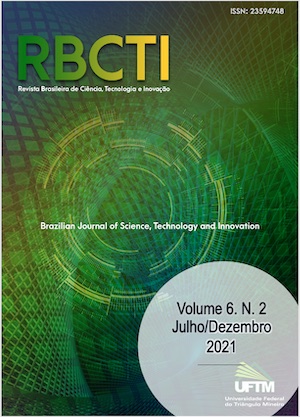Avaliação do gerenciamento de resíduos da construção civil do município de Uberaba, Minas Gerais
DOI:
https://doi.org/10.18554/rbcti.v6i2.5576Palavras-chave:
Gerenciamento de Resíduos, Ecopontos, Indicadores, Cidades de Médio PorteResumo
O presente trabalho avalia o gerenciamento ambiental, no contexto do planejamento e gerenciamento dos resíduos da construção civil (RCC) do município de Uberaba, identificando fatores que influenciam no modelo atual e contribuindo com sugestões de melhorias. O estudo fundamenta-se na pesquisa exploratória, por meio de análise de informações qualitativas e quantitativas, entrevistas com profissionais da área e observações de campo nos ecopontos do munícipio. Com base nos resultados observa-se que Uberaba possui leis locais que dão as diretrizes e critérios para o manejo dos RCC, como a Lei nº 10.876, de 11 de dezembro de 2009, a qual abrange todo ciclo produtivo dos materiais, além de dispor de ecopontos para o descarte ambientalmente correto pelos munícipes. São apontados nesse estudo fatores que interferem no modelo atual, por meio de análise de indicadores, da eficiência dos ecopontos e do papel da população diante do gerenciamento dos RCC. Os dados coletados no Sistema Nacional de Informação sobre Saneamento (SNIS) apresentam um aumento na geração de RCC pela população, com massa de RCC per capita de 351,44 [kg/(habitantes x ano)] em 2019. Destaca-se a necessidade de transparência pública dessas informações de forma mais efetiva, diante do que foi analisado, seja por falta de dados ou na divergência de informações. Cabe ao poder público acompanhar a evolução dos indicadores e promover ações corretivas nesse processo, assim como dispor de informações sobre os ecopontos para toda população, visto que o município ainda enfrenta dificuldades relacionadas ao descarte irregular de resíduos em locais inapropriados.
Referências
ABNT. ASSOCIAÇÃO BRASILEIRA DE NORMAS TÉCNICAS. NBR 10004: Resíduos sólidos - Classificação. Rio de Janeiro: ABNT, 2004.
BOURSCHEID, J. A.; SOUZA, R. L. Resíduos de construção e demolição como material alternativo. Florianópolis: IF-SC, 2010.
BRASIL. Congresso Nacional. Lei n. 14.026, de 15 de julho de 2020. Brasília, DF, 2020. Disponível em: http://www.planalto.gov.br/ccivil_03/_Ato2019-2022/2020/Lei/L14026.htm#art7. Acesso em: 1 de fev. 2021.
BRASIL. Conselho Nacional do Meio Ambiente - Conama. Resolução Conama n° 307, de 5 de julho de 2002. Diário Oficial da União, Brasília.
BRASIL. Constituição (1988). Constituição da República Federativa do Brasil. Brasília, DF: Senado, 1988. Disponível em: http://www.planalto.gov.br/ccivil_03/constituicao/constituicaocompilado.htm. Acesso em 15 out. 2020.
FAITA, M. M.; SARMENTO, L. A. V. Gestão dos resíduos da construção civil: estudo de caso em Uberaba. Colloquium Exactarum, v.7, n.4, p.26-35, 2015. DOI: http://dx.doi.org/10.5747/ce.2015.v07.n4.e136.
FERREIRA, D. D. M.; NOSCHANG, C. R. T.; FERREIRA, L. F. Gestão de resíduos da construção civil e de demolição: contribuições para a sustentabilidade ambiental. In: V Congresso Nacional de Excelência em Gestão, Gestão do conhecimento para a sustentabilidade, Niterói, RJ, Brasil. 2009. ISSN 1984-9354.
GIL, A. C. Como elaborar projetos de pesquisa. 4. ed. São Paulo: Atlas, p. 41-57, 2002.
GONÇALVES, D. B. A gestão de resíduos da construção civil no município de Sorocaba - SP. REEC-Revista Eletrônica de Engenharia Civil, v.11, n.2, 2016. ISSN: 2179-0612. DOI: https://doi.org/10.5216/reec.V11i2.35791.
LIMA, A. S.; CABRAL, A. E. B. Caracterização e classificação dos resíduos de construção civil da cidade de Fortaleza (CE). Revista Engenharia Sanitária Ambiental, v. 18, n.2, p.169-176, 2013. DOI: https://doi.org/10.1590/S1413-41522013000200009.
LIPSMEIER, K.; GÜNTHER, M.; JALALI, S.; PEREIRA, L. Manual europeu de resíduos da construção de edifícios. Dresden: TU-Dresden, 2005. v.3. Tradução de: Waste manual for building constructions. ISBN 972-8600-16-X.
MAGDALENO, A. C. R. M., NOBREGA, M. J. R. Metodologia para qualificação de obras civil sustentáveis. Revista Augustus, v. 20, n. 40, p. 70-83, 2015. DOI: http://dx.doi.org/10.15202/19811896.2015v20n40p70.
SILVA, V. A.; FERNANDES, A. L. T. Cenário do gerenciamento dos resíduos da construção e demolição (RCD) em Uberaba-MG. Sociedade & Natureza, v. 24, n. 2, p. 333-344, 2012. DOI: https://doi.org/10.1590/S1982-45132012000200012.
UBERABA. Câmara Municipal. Lei Complementar nº 389, de 11 de dezembro de 2008. Institui o Código do Meio Ambiente do Município de Uberaba, e dá outras providências. Uberaba, 2008. Disponível em: http://www.uberaba.mg.gov.br/portal/acervo/governo/arquivos/legislacao/LEI%20COMP%20389.pdf. Acesso em: 15 set. 2020.
UBERABA. Câmara Municipal. Lei nº 10.876, de 11 de dezembro de 2009. Institui o Sistema municipal para a Gestão Sustentável de Resíduos da Construção Civil e Resíduos Volumosos. Disponível em: http://leismunicipa.is/ajcvt. Acesso em: 10 mar. 2020.
UBERABA. Prefeitura Municipal. Plano Municipal de Saneamento Básico. 2014. Disponível em: http://www.codau.com.br/uploads/1415727493.pdf. Acesso em: 20 mai. 2020.
UBERABA. Prefeitura Municipal. Serviços Urbanos. 2020. Disponível em: http://uberabacontracovid.com.br/portal/conteudo,50059. Acesso em: 12 jan. 2021.
Downloads
Publicado
Edição
Seção
Licença
Copyright (c) 2022 Vinicios Henrique Schenten Alves, Bruna Lopes Coêlho

Este trabalho está licenciado sob uma licença Creative Commons Attribution-NonCommercial-ShareAlike 4.0 International License.




